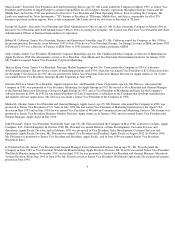Apple 1996 Annual Report Download - page 21
Download and view the complete annual report
Please find page 21 of the 1996 Apple annual report below. You can navigate through the pages in the report by either clicking on the pages listed below, or by using the keyword search tool below to find specific information within the annual report.The Company, International Business Machines Corporation ("IBM") and Motorola, Inc. have agreed upon and announced the availability of
specifications for a PowerPC microprocessor-based hardware reference platform. These specifications define a "unified" personal computer
architecture that gives access to both the Power Macintosh platform and the PC environment. The Company's future operating results and
financial condition may be affected by its ability to continue to implement this agreement and to manage the risk associated with the transition
to this new hardware reference platform.
Decisions by customers to purchase the Company's personal computers, as opposed to MS-DOS or Windows-
based systems, are often based on
the availability of third-party software for particular applications. The Company believes that the availability of third-
party application software
for the Company's hardware products depends in part on third-party developers' perception and analysis of the relative benefits of developing,
maintaining, and upgrading such software for the Company's products versus software for the larger MS-DOS and Windows market. This
analysis is based on factors such as the perceived strength of the Company and its products, the anticipated potential revenue that may be
generated, and the costs of developing such software products. To the extent the Company's recent financial losses and declining demand for
the Company's product have caused software developers to question the Company's position in the personal computer market, developers could
be less inclined to develop new application software or upgrade existing software for the Company's products and more inclined to devote their
resources to developing and upgrading software for the larger MS-
DOS and Windows market. Microsoft Corporation is an important developer
of application software for the Company's products. Accordingly, Microsoft's interest in producing application software for the Company's
products may be influenced by Microsoft's perception of its interests as the vendor of the Windows operating systems.
The Company's ability to produce and market competitive products is also dependent on the ability of IBM and Motorola, Inc., the suppliers of
the PowerPC RISC microprocessor for certain of the Company's products, to supply to the Company in adequate numbers microprocessors that
produce superior price/performance results compared with those supplied to the Company's competitors by Intel Corporation, the developer
and producer of the microprocessors used by most personal computers using the MS- DOS and Windows operating systems. IBM produces
personal computers based on Intel microprocessors as well as workstations based on the PowerPC microprocessor, and is also the developer of
OS/2, a competing operating system to the Company's Mac OS. Accordingly, IBM's interest in supplying the Company with microprocessors
for the Company's products may be influenced by IBM's perception of its interests as a competing manufacturer of personal computers and as a
competing operating system vendor.
Several competitors of the Company, including Compaq, IBM, and Microsoft, have either targeted or announced their intention to target certain
of the Company's key market segments, including education and publishing. Many of these companies have greater financial, marketing,
manufacturing, and technological resources than the Company.
The Company is integrating Internet capabilities into its new and existing hardware and software platforms. There can be no assurance that the
Company will be able to continue to do so successfully. In addition, the Internet market is rapidly evolving and is characterized by an
increasing number of market entrants who have introduced or developed products addressing access to, authoring for, or communication over,
the Internet. Many of these competitors have a significant lead over the Company in developing products for the Internet, have significantly
greater financial, marketing, manufacturing, and technological resources than the Company, or both.
The Company's future operating results and financial condition may also be affected by the Company's ability to successfully expand and
capitalize on its investments in other markets, such as the markets for MessagePad (registered trademark) and related products.
19
























